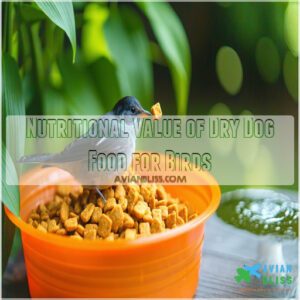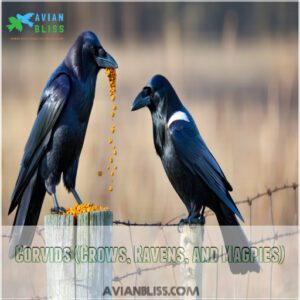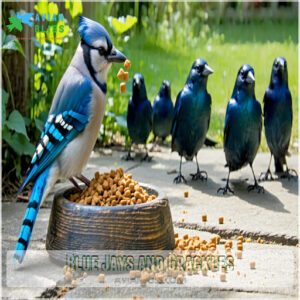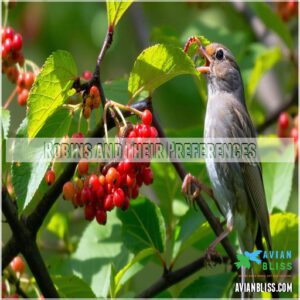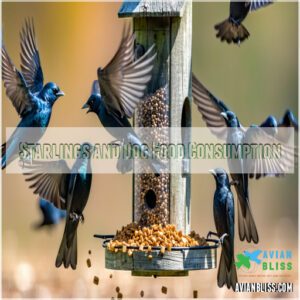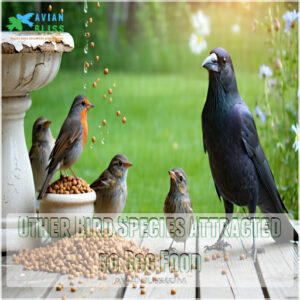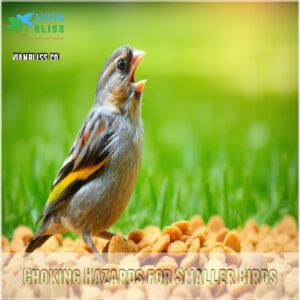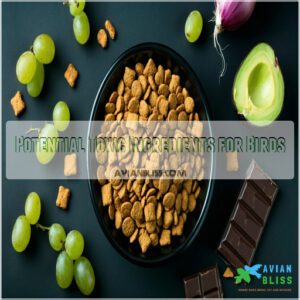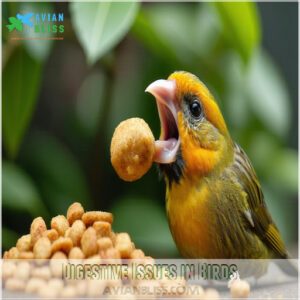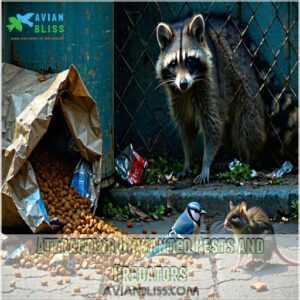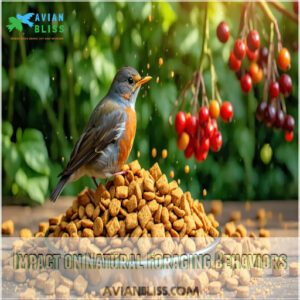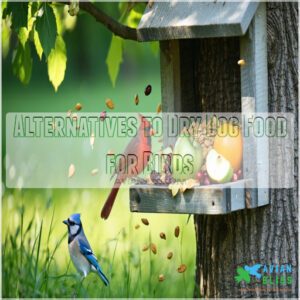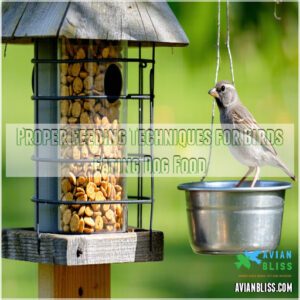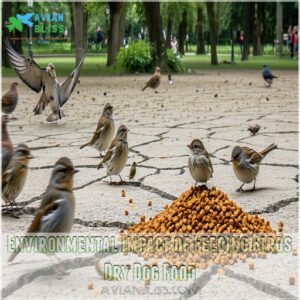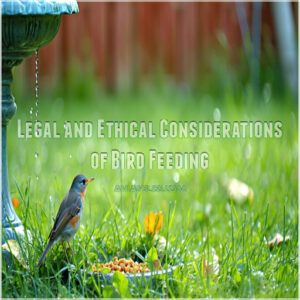This site is supported by our readers. We may earn a commission, at no cost to you, if you purchase through links.
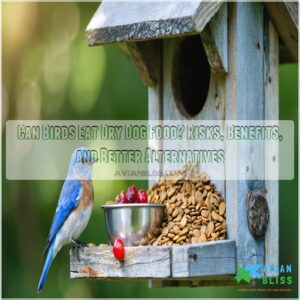
While it’s packed with protein and carbs, it’s not made for a bird’s unique needs.
Plus, some ingredients, like garlic or artificial additives, can harm them.
Smaller birds might even choke on the chunks, which is never a good thing.
Birds thrive on seeds, berries, and insects—foods they naturally eat.
Dog food’s just not part of their balanced diet and might cause health issues down the road.
Want to spoil your feathered friends? Stick to bird-friendly snacks instead.
Trust me, they’ll tweet their thanks!
Table Of Contents
- Key Takeaways
- Nutritional Value of Dry Dog Food for Birds
- Bird Species Known to Eat Dry Dog Food
- Risks of Feeding Dry Dog Food to Birds
- Alternatives to Dry Dog Food for Birds
- Proper Feeding Techniques for Birds Eating Dog Food
- Environmental Impact of Feeding Birds Dry Dog Food
- Legal and Ethical Considerations of Bird Feeding
- Frequently Asked Questions (FAQs)
- Can wild birds eat dog food?
- Which birds eat dog food?
- Can birds eat dry dog food?
- What do birds eat?
- Can baby birds eat wet dog food?
- Is dog food good for birds?
- Is it okay to feed birds dry dog food?
- What wild animals will eat dry dog food?
- Is it okay for squirrels to eat dry dog food?
- Why do birds eat my dog’s food?
- Conclusion
Key Takeaways
- Birds can eat dry dog food, but it’s not ideal for their nutrition or health. Soak it in water to make it safer and easier for them to eat.
- Avoid dog food with harmful ingredients like garlic, onion, or artificial additives, which could be toxic to birds.
- Feeding birds dry dog food risks choking, nutritional imbalances, and digestive issues, especially for smaller species.
- Stick with seeds, fruits, and insects—it’s what birds naturally thrive on and keeps them healthier long-term.
Nutritional Value of Dry Dog Food for Birds
Dry dog food is packed with protein, carbs, and some vitamins, which birds can eat, but they mightn’t get everything they need to stay healthy.
It’s like offering your bird fast food—fine once in a while, but not exactly a balanced diet!
Protein Content in Dry Dog Food
Ever wonder if dry dog food for birds is a good idea?
Turns out, it packs a solid protein punch—18-32% in most brands!
While that’s great for dogs, birds need less.
Here’s the scoop:
- Protein Levels: High but not always right.
- Amino Acids: Not bird-optimized.
- Dog Food Additives: Watch those extras!
- Nutrient Balance: Birds thrive naturally!
Essential Vitamins and Minerals
Dog food has vitamins and minerals, sure, but they’re not really balanced for birds.
While some nutrients might help with bird nutrition, others can cause problems—you risk creating a vitamin deficiency or imbalance.
Birds need their diet built for their unique needs, not leftovers from your pup’s bowl.
Stick to proper bird food rather than relying on dog food ingredients for birds, as this ensures you are providing the best possible nutrition for your bird, avoiding potential issues related to bird nutrition.
Carbohydrate Sources in Dog Food
Let’s dig into the carbs packed into dry dog food—it’s like fuel for a bird buffet.
You’ll often find energy-rich ingredients like these:
- Sweet potatoes for fiber and nutrients.
- Rice for easy digestion (a lightweight option for their tiny tummies).
- Potato-based starches in grain-free kibble.
These dog food ingredients for birds aren’t nature’s pick, but they pack some serious carb content!
Comparison With Natural Bird Diets
Birds in the wild stick to bugs, seeds, and fruits—all packed with natural goodness.
Dry dog food, however, flips the script, it’s high in protein and carbs but skimpy on bird-loving fiber and balanced nutrients.
Several bird species consume dog food, as detailed in this informative article on bird diets.
Can birds eat dog food? Yes, but it lacks their natural essentials for thriving, sure, it’s edible, but it’s like swapping a smoothie for a candy bar.
Stick to their usual bites for healthier feathered friends!
Potential Nutritional Imbalances for Birds
When you offer dry dog food to birds, you’re messing with their nutritional needs.
Birds need vitamins like A and D, plus calcium, to stay healthy, but dog food might miss these essentials.
Too much protein or fat? That can lead to avian obesity or even liver issues.
Dog food, while potentially palatable, shouldn’t replace a balanced birdseed diet.
So, can birds eat dog food? Sure, but it’s risky and imbalanced.
Bird Species Known to Eat Dry Dog Food
Some birds can’t resist snacking on dry dog food, especially bold ones like crows, grackles, and blue jays.
You might even spot robins or sparrows joining the feast, proving birds have surprising tastes!
Corvids (Crows, Ravens, and Magpies)
Corvids, like crows, ravens, and magpies, are clever birds with fascinating habits.
They’ll happily snack on dry dog food, showcasing their sharp instincts.
Is dog food safe for birds like these? For the most part, yes.
Here’s why corvids stand out:
- Crows remember faces—treat them kindly, and they’ll notice.
- Ravens use tools—no joke, they’re problem-solving pros!
- Magpies love shiny treasures—watch your keys!
- Their social behavior is amazing—teamwork comes naturally.
Corvid diet meets backyard ingenuity!
Blue Jays and Grackles
Ever notice blue jays and grackles stealing snacks meant for your dog?
These bold birds don’t mind swiping kibbles!
They’re not fussy and love protein-packed bites.
Watching them carry it off like tiny thieves can be entertaining.
But is dog food really good for wild birds?
Here’s a quick comparison:
| Trait | Blue Jays | Grackles |
|---|---|---|
| Diet Preference | Varied, loves protein | Opportunistic |
| Socialization Style | Chatty, territorial | Bold, group feeders |
| Feather Care | Frequent preening | Regular preening |
| Nesting Habits | Trees, shrubs | Bushy areas |
| Dog Food Behavior | Eats, stores food | Eats readily |
Robins and Their Preferences
Robins have a sweet tooth for nature’s buffet, skipping dry dog food for tastier options.
Their favorites?
- Earthworms – the ultimate squishy snack.
- Berries – like candy for their beaks.
- Mealworms – tiny protein-packed treats.
If you’ve watched them hop around your yard, you know their feeding habits keep them energized for nesting and raising chicks.
Starlings and Dog Food Consumption
Starlings are like the neighborhood foodies—they’re wild about kibble.
These feathered opportunists are quick to snag dry dog food, often gathering in flocks and finishing feeders faster than you can refill them.
| Behavior | Frequency |
|---|---|
| Flock feeding | Very High |
| Scavenging leftovers | High |
| Outcompeting small birds | Moderate |
| Nesting nearby | Low |
| Encouraging population growth | High |
If you’ve got starlings eating dog food, expect a crowded backyard with faster feeder depletion.
Other Bird Species Attracted to Dog Food
Sure, starlings hog the spotlight, but backyard birds like sparrows, doves, and even cheeky crows can’t resist dog food either.
These clever bird species turn kibble into a feast, often dunking it in water first!
Watching their creative avian behavior at the feeder is wild bird entertainment at its best.
Who knew your pup’s leftovers could fuel some fascinating urban birding?
Risks of Feeding Dry Dog Food to Birds
Feeding dry dog food to birds might seem harmless, but it can pose some surprising risks.
From choking on large pieces to eating toxic ingredients, it’s not always the treat you think it is.
Choking Hazards for Smaller Birds
Dry dog food might look harmless, but it can be a choking hazard for small birds. Food size matters! Those chunky kibbles don’t play well with bird beak shape or tiny throats.
Here’s why it’s risky:
- Swallowing difficulties due to size.
- Pieces block airways.
- Birds might panic mid-meal.
- Dog kibble expands when wet.
- It’s unsafe for small bird safety.
Potential Toxic Ingredients for Birds
Hidden in dog food are toxic substances no bird should nibble on.
Ingredients like avocado, garlic, chocolate, onions, and grapes can cause avian poisoning—think stomach issues, or worse.
Over-supplementation of vitamin D, a common ingredient in fortified dog foods, can lead to vitamin D toxicity in birds.
These hazardous ingredients turn a harmless snack into a major bird toxin risk.
Always scan labels or stick to dog food alternatives safe for them.
Why risk it?
Digestive Issues in Birds
Think birds can handle dry dog food? Their tiny guts disagree.
Dog kibble’s dense, tough texture isn’t built for Bird Gut Health and can cause digestive issues like blockages or Feeding Disorders.
Soaking dry dog food helps, but it’s still far from ideal.
Here’s what happens to their tummies:
- Difficulty breaking it down.
- Risk of Gastrointestinal Problems.
- Poor Avian Nutrition absorption.
- Potential Dietary Toxicity buildup.
Attracting Unwanted Pests and Predators
Feeding birds dry dog food can feel like inviting the neighborhood wildlife over.
Sure, it’s great for birds, but it’s also a beacon for troublemakers.
- Rodents love free snacks, and they’ll return with friends.
- Raccoons might join for a messy midnight buffet.
- Urban wildlife, like opossums and stray animals, can disrupt your ecosystem.
Effective pest control methods? Keep food areas clean!
Impact on Natural Foraging Behaviors
Feeding wild birds dog food might seem helpful, but it messes with their foraging patterns and natural instincts.
Birds adapt by skipping their usual hunt for worms, seeds, or fruits, and easy snacks could make them lazy, leading to unhealthy feeding habits.
Here’s how dog food compares to natural sources:
| Dog Food | Natural Foods |
|---|---|
| Packed with carbs | Balanced nutrients |
| Easily accessible | Requires effort |
| Lacks diversity | Rich variety |
| Can disrupt ecology | Maintains balance |
Alternatives to Dry Dog Food for Birds
If you’re looking for better options than dry dog food, there are plenty of bird-friendly choices out there.
From seeds and fruits to homemade recipes, you can offer birds something healthier and more natural they’ll actually enjoy, which can be considered a healthier alternative.
Commercial Bird Feed Options
Why settle for dry dog food for birds? Check out bird food options like seed blends, energy-packed suet cakes, or nutrient-rich feed pellets.
These are designed just for birds, making them a safer, smarter pick. A variety of bird seed blends are available for purchase online.
Throw in some nutrient supplements for a diet win! With these treats, you’ll have a bird buffet that’s way better than commercial dog food.
Natural Food Sources for Wild Birds
Nature’s menu for wild birds beats dry dog food any day!
Boost bird nutrition with these natural food sources:
- Berry Nutrition – Plant shrubs like elderberries or blueberries; birds love the sweet rewards.
- Seed Selection – Toss sunflower seeds in your garden, and watch birds flock in.
- Insect Foraging – Keep a compost pile buzzing with bugs; it’s protein-packed snacking.
For convenient options, consider exploring natural bird food products available online.
Homemade Bird Food Recipes
Skip the store-bought stuff—try these homemade bird food recipes instead! You can also find a variety of homemade bird food products online.
Recipe Type Ingredients Best For
Keep it fresh and safe, and watch those birds flock in!
Seasonal Feeding Considerations for Birds
When the seasons change, so should your bird menu.
Birds need the right fuel for their activities year-round:
- In spring, help with nesting by offering protein-packed snacks like mealworms.
- During summer, add fresh fruits or softened dry dog food to support bird nutrition.
- For autumn, energy-rich treats like sunflower seeds keep birds strong through molting and migration.
Understanding bird behavior seasonal patterns is essential for providing the right food at the right time.
Specialized Feeds for Different Bird Species
Let’s focus on feeds suited to specific birds, from protein-packed mealworms for robins to sunflower seeds loved by cardinals, every bird’s got its thing.
Check this quick guide:
| Bird Species | Favorite Food | Feeding Tip |
|---|---|---|
| Cardinals | Sunflower seeds | Use a covered feeder |
| Robins | Mealworms | Offer fresh, wriggly ones |
| Blue Jays | Peanuts | Use a platform feeder |
| Finch | Nyjer seeds | Choose a tube feeder |
| Doves | Millet | Sprinkle directly on ground |
Target their tastes, and they’ll flock!
Proper Feeding Techniques for Birds Eating Dog Food
If you’re feeding birds dry dog food, it’s important to do it the right way to keep them safe and healthy.
From soaking kibble to choosing the right feeder, a few simple steps can make all the difference, with complete concepts like these being crucial for the birds’ well-being.
Appropriate Feeder Types for Dog Food
Choosing the right feeder design makes feeding birds dry dog food a breeze.
Tray feeders or ground trays work perfectly, giving birds easy access.
For extra fun, some birds like softening dog food in birdbath feeders.
Consider various bird feeder types for different seed preferences.
Avoid hanging feeders—they’re tricky for heavier food.
Place feeders where birds feel safe, away from pets or nosy pests.
Feeding birds should be simple and joyful!
Portion Control and Feeding Frequency
Feeding wild birds dry dog food? Portion control’s key! Birds eating dog food can easily overindulge, so start small and adjust based on what’s eaten.
Great feeding schedules? Twice a day works wonders—morning and evening, when bird appetite peaks.
Keep food rationing simple:
- Stick to a small daily allowance.
- Adjust meal sizes for bird species.
- Watch for leftovers! This approach ensures effective feeding and helps in maintaining a healthy balance.
Mixing Dog Food With Bird-Specific Foods
Wondering how to level up your bird buffet? Try mixing dog food with bird-specific foods!
Toss in seeds, some fruit bits, or even a dash of mealworms for a protein-packed treat.
This nutrient blending adds variety and makes their meal feel gourmet. It’s not just about “birds eating dog food”—it’s about creating a balanced feast they’ll flock to enthusiastically.
Hygiene and Maintenance of Feeding Areas
Don’t turn your feeding area into a germ factory! Clean feeders and bird baths weekly with warm, soapy water, rinsing thoroughly.
Sweep up leftover food for proper waste management—it keeps pests away. Store bird food in sealed containers to prevent spoilage.
These small steps guarantee bird feeding safety and give your feathered visitors a healthy, pest-free hangout spot. Stay tidy, stay safe!
Monitoring Bird Health and Behavior
Keep an eye on your birds—they’ll show you if something’s off.
Watch these signs:
- Bird Weight: Sudden drops mean the nutritional value of dog food mightn’t cut it.
- Feather Condition: Ragged feathers? Dog food harmful to birds could be why.
- Beak Health: Cracks or weaknesses?
- Nesting Habits/Flocking Patterns: Odd changes hint at an unbalanced bird diet!
The signs mentioned are critical to understanding the health and well-being of your birds, and monitoring them closely can help identify potential issues early on.
Environmental Impact of Feeding Birds Dry Dog Food
Feeding birds dry dog food might seem harmless, but it can shake up local ecosystems in surprising ways.
You could unintentionally mess with migration patterns or even disrupt the natural food chain, so it’s worth thinking twice!
Changes in Local Bird Populations
Ever notice unusual visitors at your feeder?
That dog food buffet might trigger population shifts and alter bird diversity in your area.
Birds that dominate feeders can disturb smaller species and change habitat use.
Here’s a glance at the impacts:
| Impact | Local Bird Species | Habitat Changes | Species Interactions | Ecosystem Effects |
|---|---|---|---|---|
| Increased Numbers | Crows, Grackles | Urban Dominance | Push Out Small Birds | Less Pollination |
| Reduced Diversity | Few Species Thrive | Fewer Nesting Spots | Aggression Rises | Altered Food Web |
| New Species Sighted | Migrants Arrive | Sharing Spaces | Unstable Balance | Weaker Ecosystem |
| Spread of Pests | Rats, Pigeons | Shrinking Homes | Resource Competition | Contamination Risk |
| Overreliance on Food | Reliant Populations | Loss of Wild Diet | Reliance Grows | Ecological Bottleneck |
Think twice!
The risks of dog food for birds aren’t just nutritional – it shapes the world around you.
What do you see happening in your yard?
Effects on Bird Migration Patterns
Feeding birds dog food might mess with their migration patterns more than you think. Too much food can keep them hanging around longer than usual or even change their usual pitstop spots.
Here’s how it can play out:
- Birds delay migrating because meals are too easy.
- Seasonal feeding can shift where they settle.
- Overfeeding causes population clusters and habitat changes.
Too much food can cause birds to delay migrating because meals are too easy, potentially shifting where they settle due to seasonal feeding. Overfeeding can also lead to population clusters and habitat changes.
Ecological Balance in Urban Areas
Urban wildlife thrives on a careful balance, but tossing dry dog food into the mix can stir things up.
Feeding birds in urban areas might seem harmless, yet it can reshape ecosystems.
Understanding bird feeding practices is important for maintaining ecological harmony in these areas.
Here’s a quick peek:
| Impact | Feeding Dog Food | Not Feeding |
|---|---|---|
| Biodiversity | More bird types | Natural levels |
| Invasive Species | More likely | Less common |
| Green Spaces Usage | Reduced pressure | Normal dependence |
Bird feeding can either support or mess with biodiversity conservation.
Balance is key—urban areas deserve thoughtful city planning to guarantee long-term ecological harmony, ensuring a careful balance and maintaining ecological harmony.
Potential Spread of Diseases Among Birds
Feeding birds dry dog food might invite trouble.
Here’s why:
- Avian Disease Transmission: Birds crowding over food spreads sickness fast.
- Wild Bird Epidemics: Shared sources turn feathered friends into unwanted disease vectors.
- Bird Health Risks: Poor nutrition weakens their defenses, making it easier for disease to take hold.
Stick to safe bird food for healthier wildlife eating habits!
Impact on Natural Food Chain Dynamics
Offering dry dog food to birds can jumble the food web, messing with species interactions and causing ecosystem disruption.
It might even boost invasive species while cutting biodiversity.
Predators adapt, creating unexpected habitat changes.
Stick to natural food sources to support wild bird nutrition and keep ecosystems steady, and let’s not turn snack time into nature’s chaos!
Legal and Ethical Considerations of Bird Feeding
You’ve got to think about more than just birdseed when feeding birds—did you know there are laws and ethical concerns about it too?
Keeping wildlife safe while avoiding harm to the environment is a big responsibility, but it’s easier than it sounds!
Local Regulations on Feeding Wildlife
Before putting out food for birds, check those wildlife protection laws!
Many areas ban feeding wildlife to preserve local ecosystems and avoid pests or predators.
Cities often have community guidelines—like lifting feeders five feet high or keeping specific hours.
Ignoring these rules could lead to fines or harm conservation efforts.
Stay informed—it’s your responsibility!
Responsibility Towards Bird Health and Safety
Your backyard buffet comes with responsibility.
It’s about keeping everyone safe and healthy—not just tossing scraps and hoping for the best.
Always pick foods that help, not hurt.
Keep feeders squeaky clean to stop germs, and look out for sick visitors.
Block predators from turning your yard into their snack bar.
Bird safety starts with these simple steps:
- Pick safe, nutritious choices like seeds or soaked kibble.
- Clean feeders weekly—nobody wants bird flu spreading.
- Watch for strange behavior; sick birds need help fast.
- Place feeders wisely—away from cats or lurking dangers.
Balancing Human Intervention With Nature
Feeding wild birds dry dog food might feel helpful, but it’s tricky.
Too much human impact can upset nature’s rhythm, throwing off the ecological balance.
Birds may rely on your offerings and skip natural foraging, which harms wildlife conservation.
Aim for sustainable practices—fresh water, natural food sources, and mindful choices—to support nature preservation without tipping the scales.
Education and Community Awareness
Helping folks learn about bird feeding starts with you! Share tips like the nutritional value of dog food for birds and safer options.
Spark chats with neighbors about smart bird feeding for bird conservation.
- Chat at local events to boost wildlife education.
- Use social media for community outreach and environmental awareness.
- Host fun workshops on bird feeding and public engagement!
Long-term Effects on Bird Populations
Ever noticed how tossing out dry dog food feels harmless?
But it can mess with bird populations over time.
The nutritional value isn’t always right, and it might encourage dependence, messing up natural foraging instincts.
Add in habitat loss and bird migration changes, and you could see long-term effects like ecosystem disruption or, worst-case, species extinction.
Let nature lead!
Frequently Asked Questions (FAQs)
Can wild birds eat dog food?
Imagine serving up a surprise buffet—yes, wild birds can eat dog food.
It’s high in protein and nutrients, but soak dry pieces first so nobody chokes.
Keep it fresh and safe for feathered friends!
Which birds eat dog food?
Birds like crows, jays, grackles, sparrows, and starlings enjoy dog food—dry or soaked in water.
Even backyard favorites like cardinals and bluebirds might sneak a taste.
It’s like a buffet for feathered friends!
Can birds eat dry dog food?
Yes, birds can eat dry dog food, but it’s better to soak it in water first so it’s easier to eat.
Just use good quality, avoid harmful ingredients, and don’t make it their main meal.
What do birds eat?
Not everything with wings munches the same thing—birds can be picky.
They’ll go for seeds, fruit, bugs, veggies, and even some leftovers.
It’s like their version of a buffet, minus the fancy plates.
Can baby birds eat wet dog food?
Baby birds can eat wet dog food, but soften it well and mash it enough for tiny beaks.
Stick to small portions—too much isn’t great.
Think of it as a backup, not a main course!
Is dog food good for birds?
Dog food can be okay for birds in small amounts—it’s packed with protein and energy.
But don’t overdo it.
Stick to high-quality brands, soak it first, and mix in natural foods they’d normally eat!
Is it okay to feed birds dry dog food?
Feeding birds dry dog food is okay in moderation but soak it first to avoid choking.
Keep portions small, choose high-quality, and place it safely.
Just don’t replace their natural diet—it’s supplemental, not dessert!
What wild animals will eat dry dog food?
Surprisingly, dry dog food attracts more than just birds.
You might see raccoons, foxes, opossums, skunks, and even squirrels sneaking a bite.
Keep an eye out; it’s like hosting a backyard buffet!
Is it okay for squirrels to eat dry dog food?
Squirrels can eat dry dog food, but it’s not the best choice for them.
It lacks the nutrients they need and could upset their stomachs.
Stick to nuts, seeds, and veggies for ideal squirrel snacking!
Why do birds eat my dog’s food?
Birds love easy snacks, and your dog’s food is a jackpot of protein and carbs they can’t resist.
They swoop in for a free meal, especially if it’s left out and easy to grab.
Conclusion
Feeding birds dry dog food might seem harmless, but it’s not the best choice.
Sure, it’s packed with protein, but it’s just not built for their needs.
Tiny birds might choke, and some ingredients could harm their health.
Instead, offer seeds, berries, or bird-friendly snacks—they’ll love it and stay healthier.
So, can birds eat dry dog food? Technically yes, but they’ll thrive on better options.
Got a bird snack tip? Share it and keep the conversation flying!
- https://backyardwildlifeconnection.com/2019/01/24/some-wild-birds-will-eat-dry-dogfood/
- https://www.birdforum.net/threads/dog-food-for-the-birds.19485/
- https://www.dogster.com/dog-nutrition/how-to-keep-birds-away-from-dog-food
- https://www.startribune.com/how-about-feeding-dog-kibble-to-the-birds/391733171
- https://www.fws.gov/story/hidden-harm-feeding-your-local-wildlife

